Whether you are a birdwatcher from Virginia or are simply vacationing at its beaches, you will want to check out the local birds. Many of the shoreline birds seen in Virginia are migratory, meaning they fly south for the cold winter months and return to Virginia once the temperatures warm up in the spring. Some shoreline birds can only be seen in Virginia on a layover as they gear up to continue their trek south. You will see everything from traditional sandpipers at the beach to hooded mergansers along the calmer coastal waterways and sound. The array of colors and musical notes of these birds of Virginia’s coastline will fill any nature-loving person with delight and peace.
1. American Avocet (Recurvirostra americana)
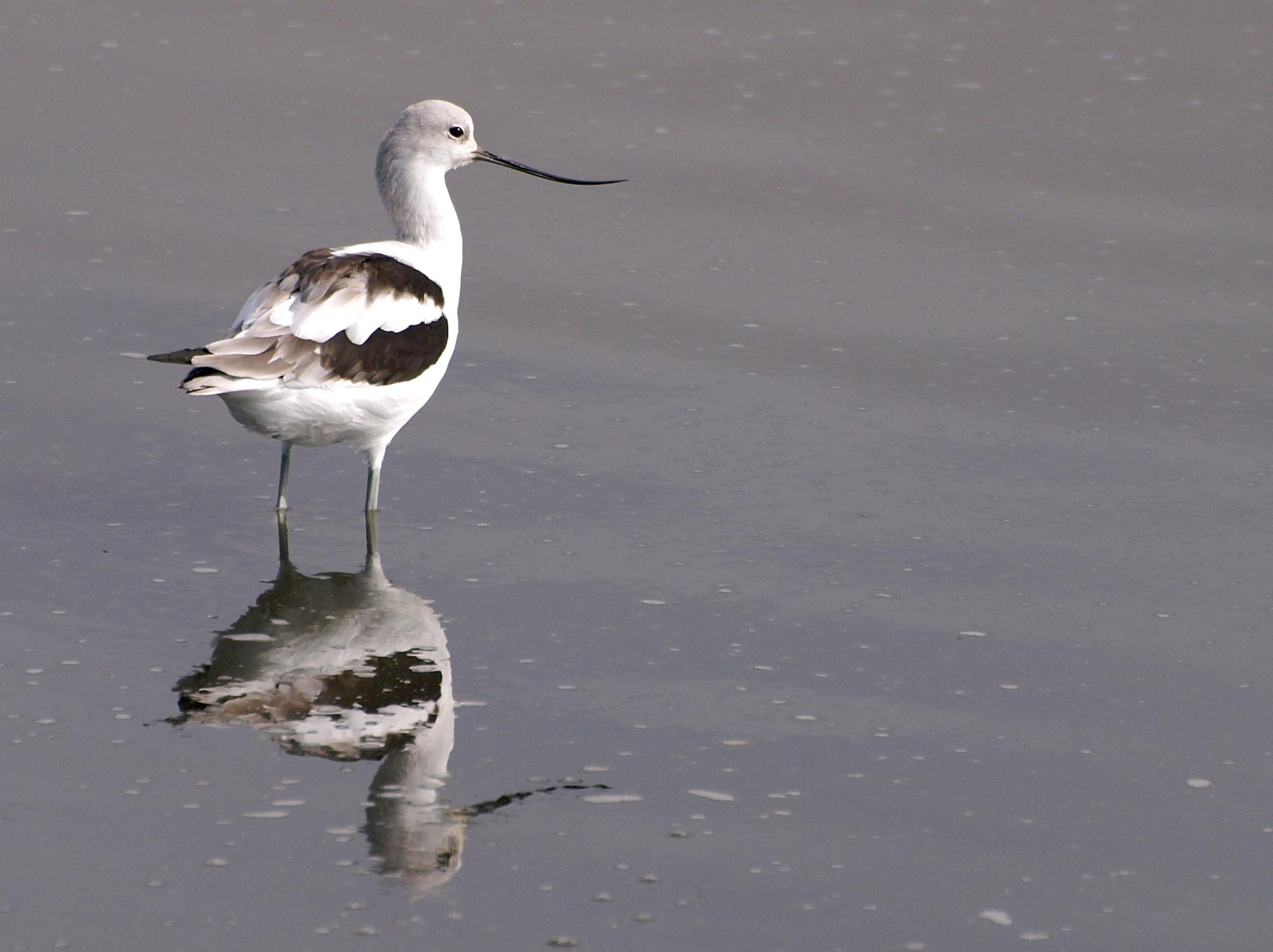
American Avocets have unique feet with a combination of webbing and big toe, called a hallux.
©Ingrid Taylar from San Francisco Bay Area – California, USA, CC BY 2.0, via Wikimedia Commons – Original / License
Avocets and stilts are both from the same family of birds; Recurvirostridae. The American Avocet is the only coastal Virginian bird with an upcurved bill, an all-white belly, and bright black and white markings on its back and wings. During the summer, they trade some of the white of their bellies for a rusted color. In winter, it resumes being white to help blend in with the snow. This surf-n-turf avocet is a forager of the shoreline and briskly whips its beak back and forth in the shallow waters while perched on its tall spindly legs. They are not large birds, with their average length measuring 16.8-18.3 inches and a wingspan of 35.5 inches.
You can find them throughout the United States, with the eastern avocets tending to remain near the water or beach throughout Virginia to Florida. They are also commonly seen on the Baja Peninsula in California and sporadically throughout the upper Midwest. They fool predators by crouching on the ground in marshes where they do not have eggs to incubate.
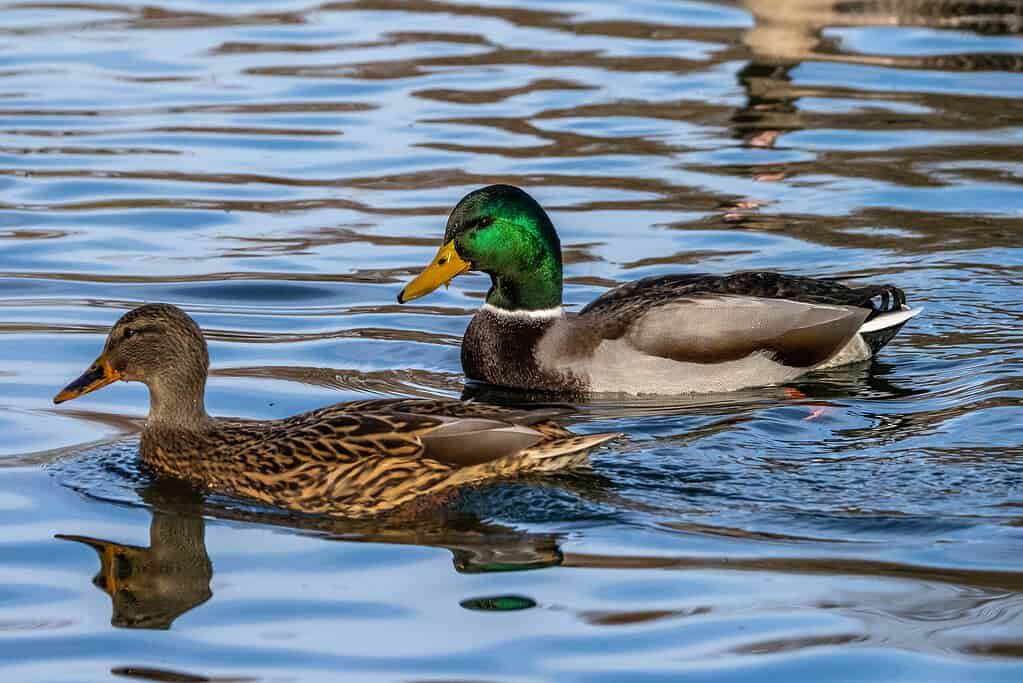
Mallard ducks (Anas platyrhynchos) swim in a lake, hoping for a snack from their human friends.
©iStock.com/Rudolf Ernst
Mallards are one type of duck that is very comfortable around humans and can often be seen anywhere from marshes to the pond in your backyard. They are also one of the most recognizable of our feathered friends. They are medium-sized dabbling ducks at 20-26 inches long and have a wingspan of 32-39 inches long. The quack of the female mallard is the universally recognized “duck sound.” Contrary to popular belief, ducks should steer clear of bread but feed on cereal, seeds, and other human snacks.
3. American Coot (Fulica Americana)
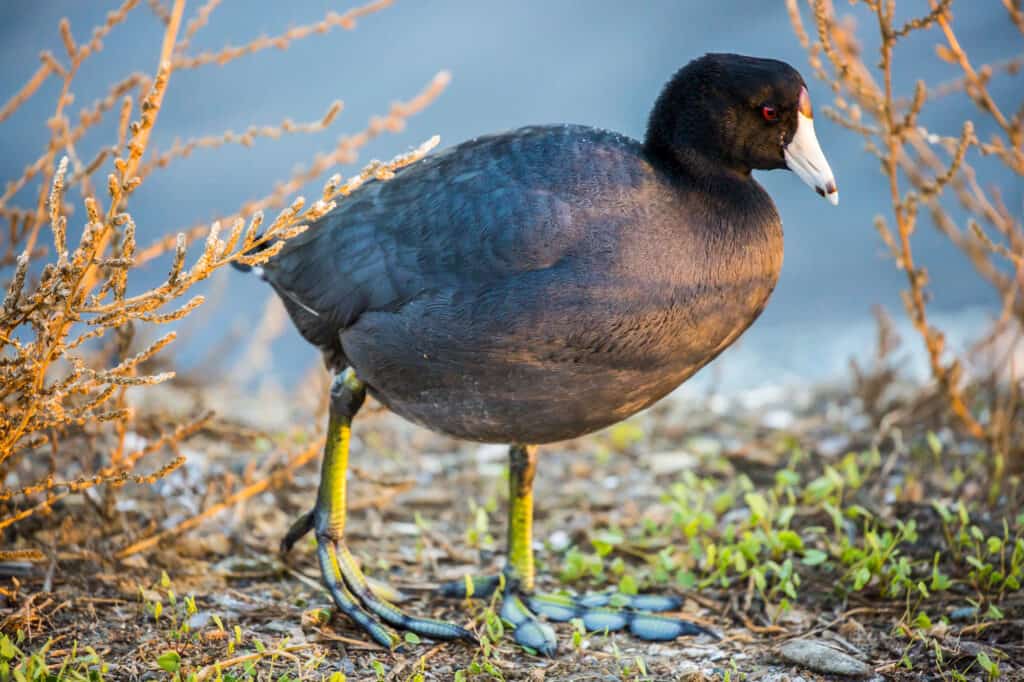
American Coots, often mistaken for ducks, are commonly found along the Virginia shore during the breeding season.
©yhelfman/Shutterstock.com
The American coot is a unique-looking bird with round red eyes, a white bill, scaled feet, and a chicken-like body. They almost look like someone stuck parts from several different types of birds together to make one plump and odd-looking little feathered friend. They are slight at 16 inches in length and have tiny tails and a small wingspan of 23-28 inches. These odd little fellows have been recorded living to the ripe old age of 22 years. During the summer breeding season, you can see them having just migrated to the Virginia coast.
4. American Woodcock (Scolopax minor)
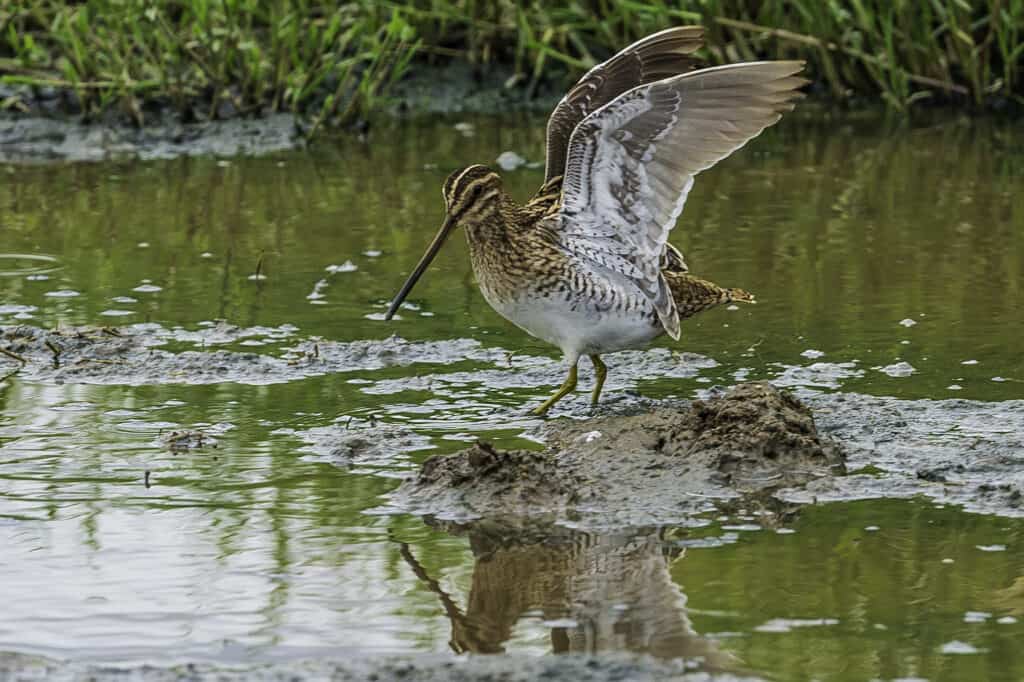
The large eyes of the American woodcock positioned high on its head give this little bird some of the most excellent vision in the bird world.
©iStock.com/Gerald Corsi
The American Woodcock is a bird with a funny name and even funnier nicknames; bogsucker, timberdoodle, and hokum poke, to name a few. Adults are undersized at 10-12 inches long and have a wingspan of 16.5-18.9 inches. The males perform a spectacular dance during mating season and display magnificent head plumage. The females are a bit larger than the males, and though they are related to the sandpiper, they prefer the brush in the marsh over the sandy beaches.
5. Bald Eagle (haliaeetus leucocephalus)

Eagles can reach 75-99 mph speeds while diving through the air.
©FloridaStock/Shutterstock.com
Bald Eagles symbolize the United States and our freedom, but their grace and beauty far surpass their symbolism in the human world. These large birds of prey are known for their enormous nests (13+ feet deep!), tight bonds with their mates, and exceptional predatory abilities. Bald eagles are giant at 28-40 inches long with a wingspan of 5 feet 11 inches – 7 feet 7 inches. These beautiful birds weigh 10-15 pounds as adults. During mating season, these large birds can be found along any body of water, favoring marshes and coastal areas.
6. Black-Capped Petrel (Pterodroma hasitata)
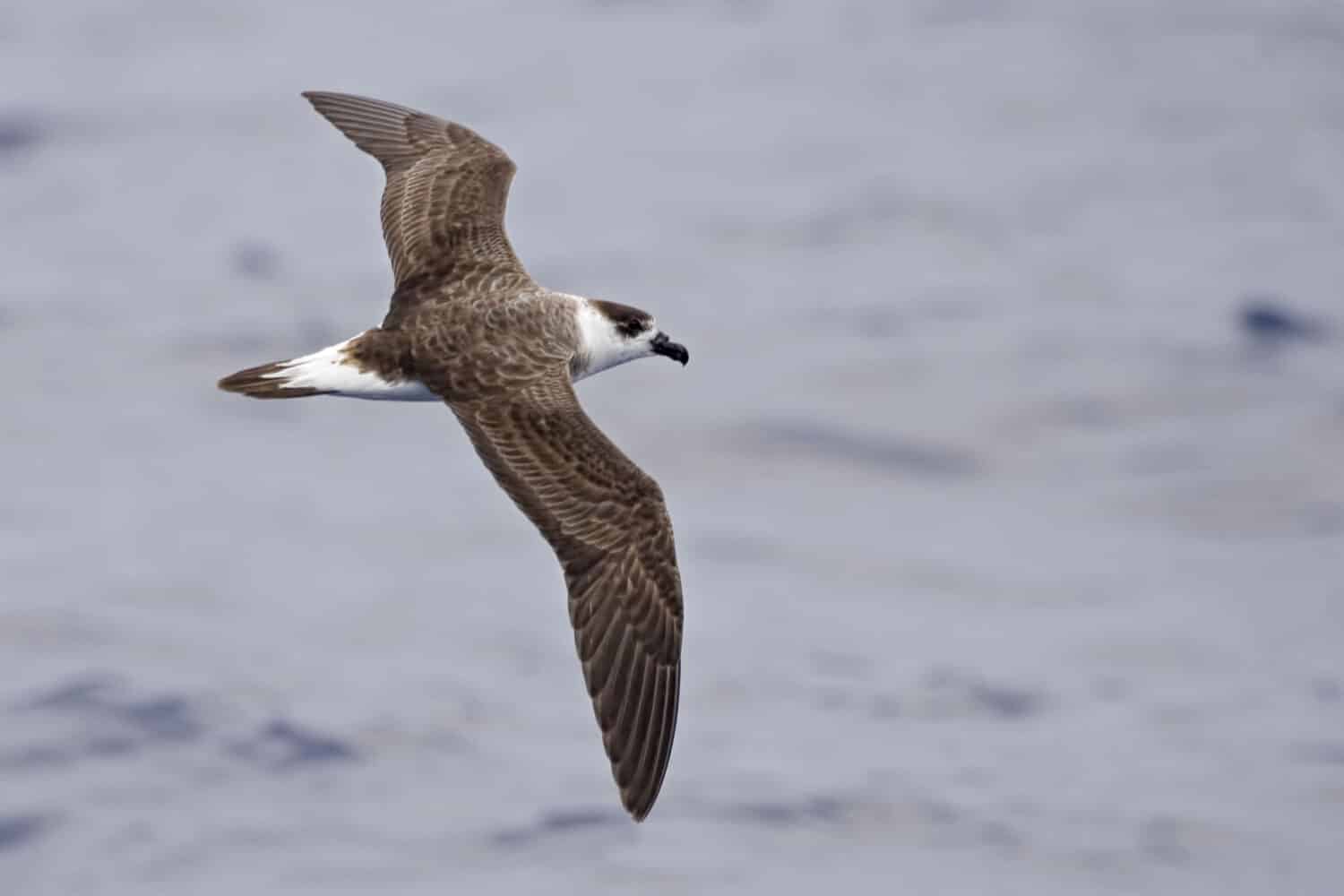
Black Capped Petrels are on the endangered species list.
©Harold Stiver/Shutterstock.com
This small and widely seen seabird is native to the West Indies but is in coastal areas throughout the United States. Black-capped petrels are relatively small coastal birds with lengths of 16 inches and wingspans of 37 inches, but they are more significant than most other petrels. Their nickname is Diablotín, meaning little devil, due to their nighttime activities and odd-sounding mating call, making locals believe them to be evil spirits in the dark. When these birds are seen in Virginia coastal lands, it is during the non-breeding season. The petrels tend to nest on tall cliffs in small caves. Sadly, they have become one of the most endangered species of birds of the North Atlantic, along with its relative, the Bermuda Petrel.
7. Black-Necked Stilt (Himantopus mexicanus)
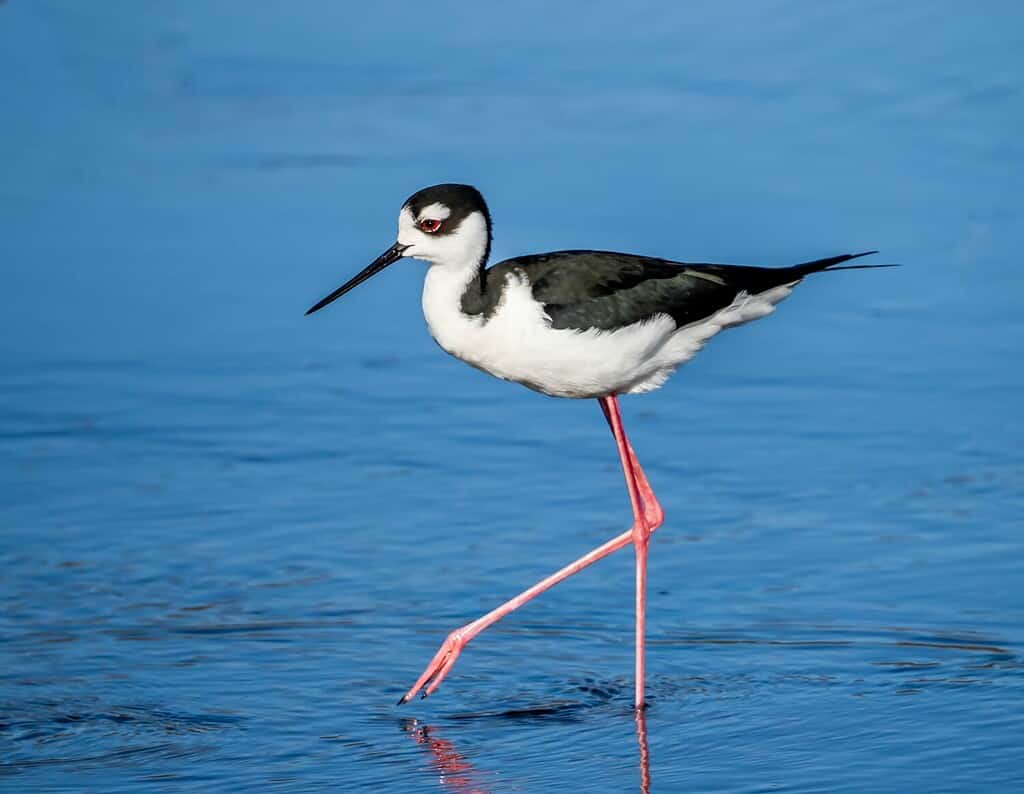
Black Necked Stilts typically lay four eggs in a nest guarded ferociously by both parents.
©Jim Schwabel/Shutterstock.com
Black-necked stilts are adorable black and white birds upon long pink stilt-like legs. These slender and graceful creatures are abundant among the coastal lands of the eastern Americas. They are 13.8-15.9 inches in length and have a wingspan of 28.1-29.7 inches. The small white spot above their eyes looks like an eyebrow. These long-legged coastal birds search for crustaceans and anthropods in shallow waters. You will most likely see them in Virginia breeding in late April through August.
8. Cedar Waxwing (Bombycilla cedrorum)
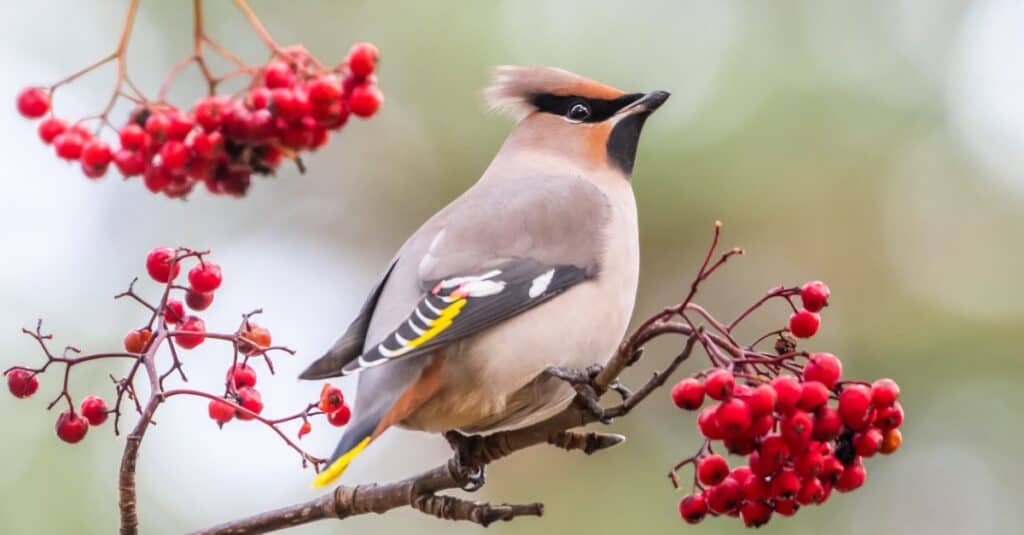
The wax-like tips of the cedar waxwing’s feathers are its namesake.
©iStock.com/hannurama
These small berry-eating birds are 5-7 inches long and have 8.7-11.6 inches wingspan. Frequently seen on the coast, these are not beach birds and tend to have a similar diet to inland birds, including worms, berries, seeds, and other insects. These are very social birds and often groom each other.
9. Dark-Eyed Junco (Junco Hymalis hymalis)

Baby dark-eyed juncos lay two clutches of four eggs per breeding season.
©JPL Designs/Shutterstock.com
This tiny bird is closely related to the sparrow and has 15 subspecies identified. The dark-eyed junco is typically 5.1-6.9 inches in length and has a wingspan of 7.1-9.8 inches. They can commonly be seen year-round at coastal Virginia birdfeeders.
10. Dunlin (Calidris alpina)
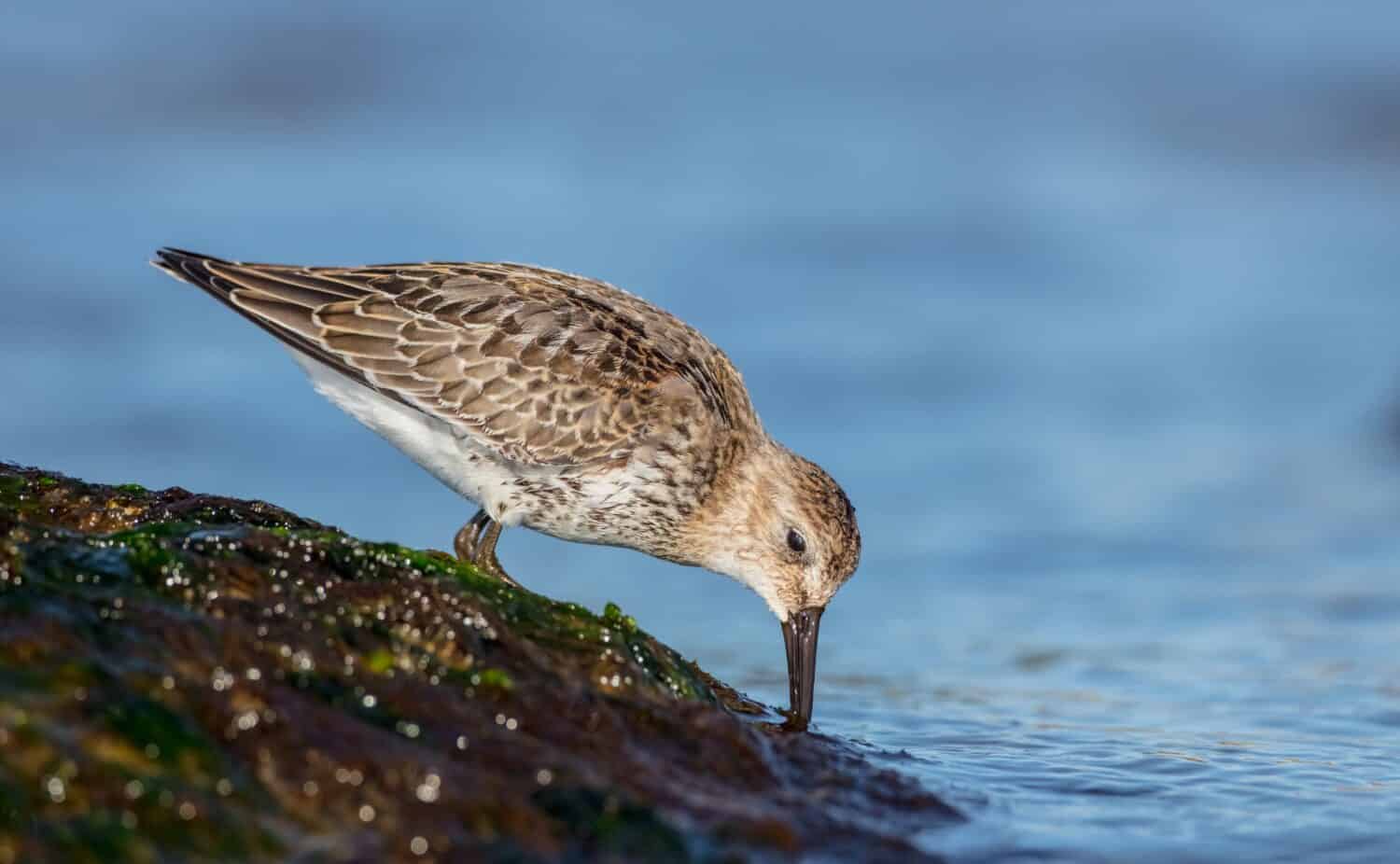
A young dunlin in search of a meal on a seaweed slick rock.
©Simonas Minkevicius/Shutterstock.com
The dunlin is small, measuring 6.3-8.7 inches in length, and has a wingspan of 14.2-15 inches. On the tip of the dunlin’s bill is a soft spot that fills with blood and nerve endings and aids them in finding invertebrates in the muddy and sandy banks. Their nests are shallow holes in marshy vegetation surrounded by twigs. Though their population worldwide is still significant, it is decreasing.
11. Great Blue Heron (Ardea herodias)
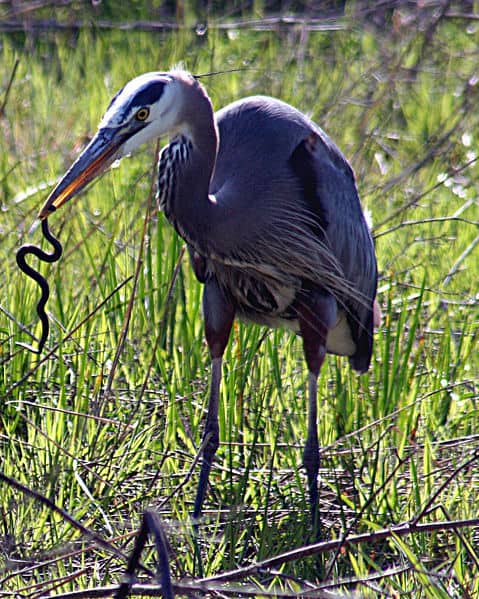
Blue heron in the Virginia marshlands making a meal of a water snake.
The great blue heron is the most prominent heron native to North America. They are twice the size and weight of white egrets at 36-54 inches long and have a wingspan of 66-79 inches. They can be found year-round near Virginia coastal waters. Blue herons have an uncanny way of walking 8 inches at a time in a close-to-perfectly straight line.
12. Greater Yellowlegs (Tringa melanoleuca)
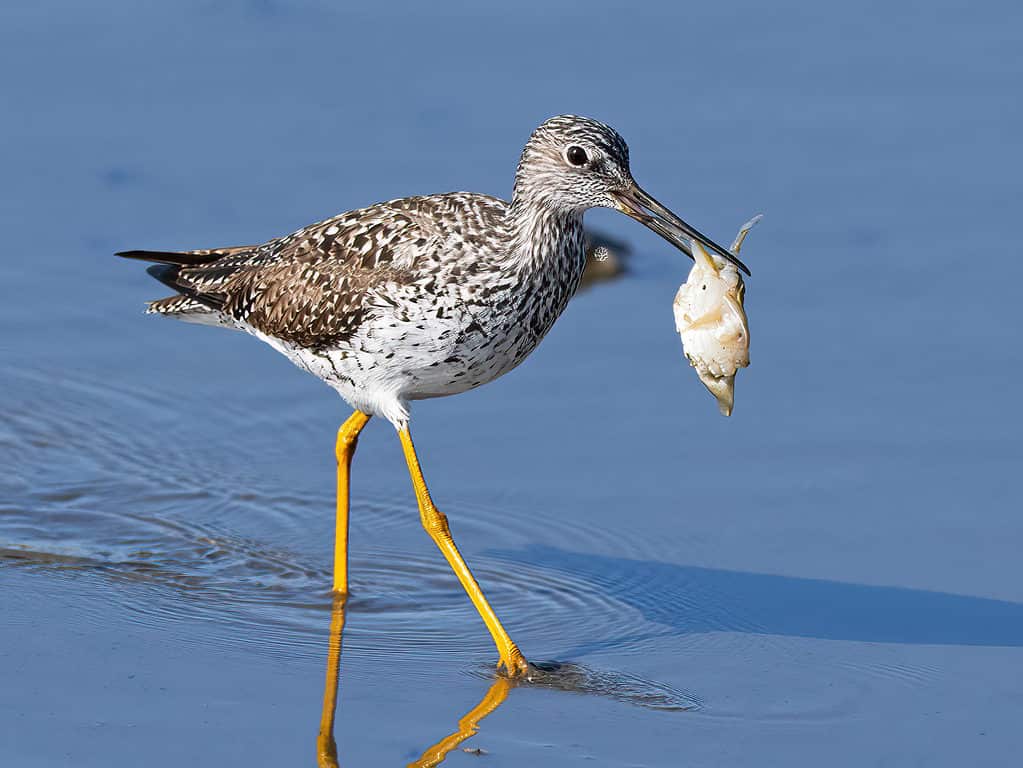
Greater Yellowlegs with a just-caught crab.
©iStock.com/BrianEKushner
The cute greater yellowlegs is a year-round resident of the Virginia coast. Its slightly upcurved, darkly colored bill is longer than its head. It ranges from 11-16 inches and has a wingspan of approximately 24 inches. They nest on the ground in wetland areas, and their offspring leave the nest 24 hours after they hatch. That’s some super speedy parenting duties!
13. Hooded Merganser (Lophodytes cucullatus)
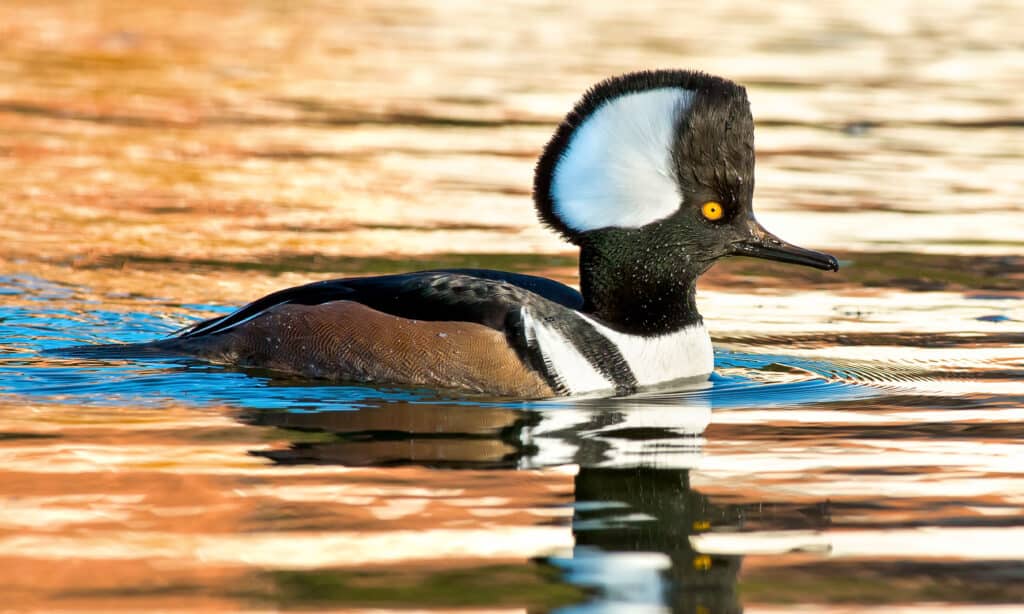
A hooded merganser casually shows off his fancy plumage.
©Paul Reeves Photography/Shutterstock.com
This flamboyant fish-eating duck isn’t just a pretty face; they are also excellent divers. They tend to hunt by sight while underwater. These medium-sized coastal birds are generally 15.8-19.3 inches in length and have a wingspan of 23.6-26 inches. The males have plumage that they can raise and lower while searching for a mate. These birds are seen year-round on the coast of Virginia.
14. Killdeer (Charadrius vociferous)
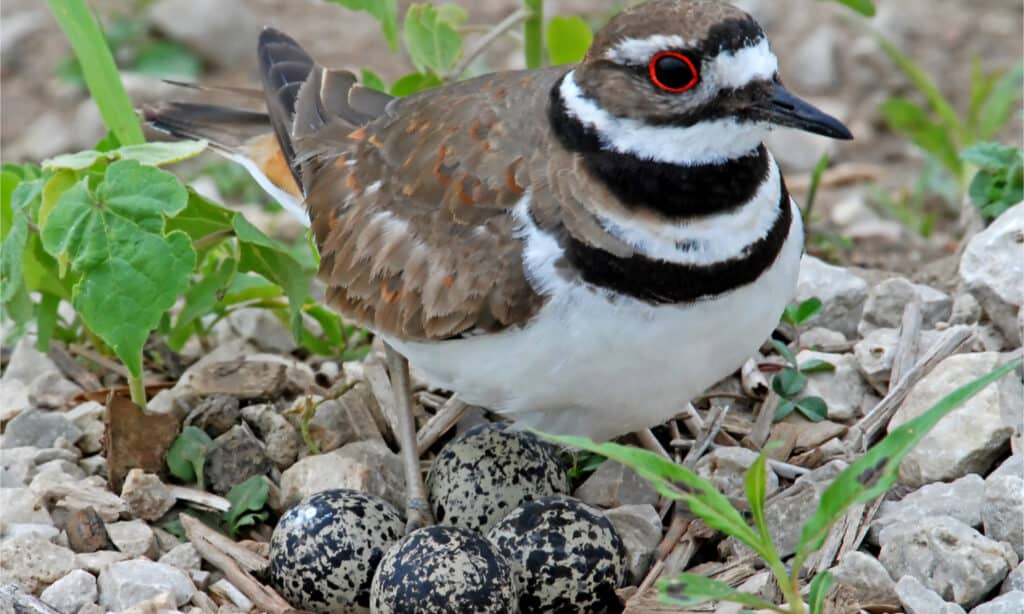
The killdeer prefers to nest in short vegetation, rooftops, and sometimes rocky coastlines.
©Brian A Wolf/Shutterstock.com
These small reddish-orange-eyed Virginia birds love to hang out on the coast, but you will not find them nesting there. Instead, they tend to nest in short grass or rooftops. They are not large at 7.9-11 inches in length and have a wingspan of 23-25 inches. These little guys are very vocal and named for one of their many sounds.
15. Long-Billed Dowitcher (Limnodromus scolopaceus)
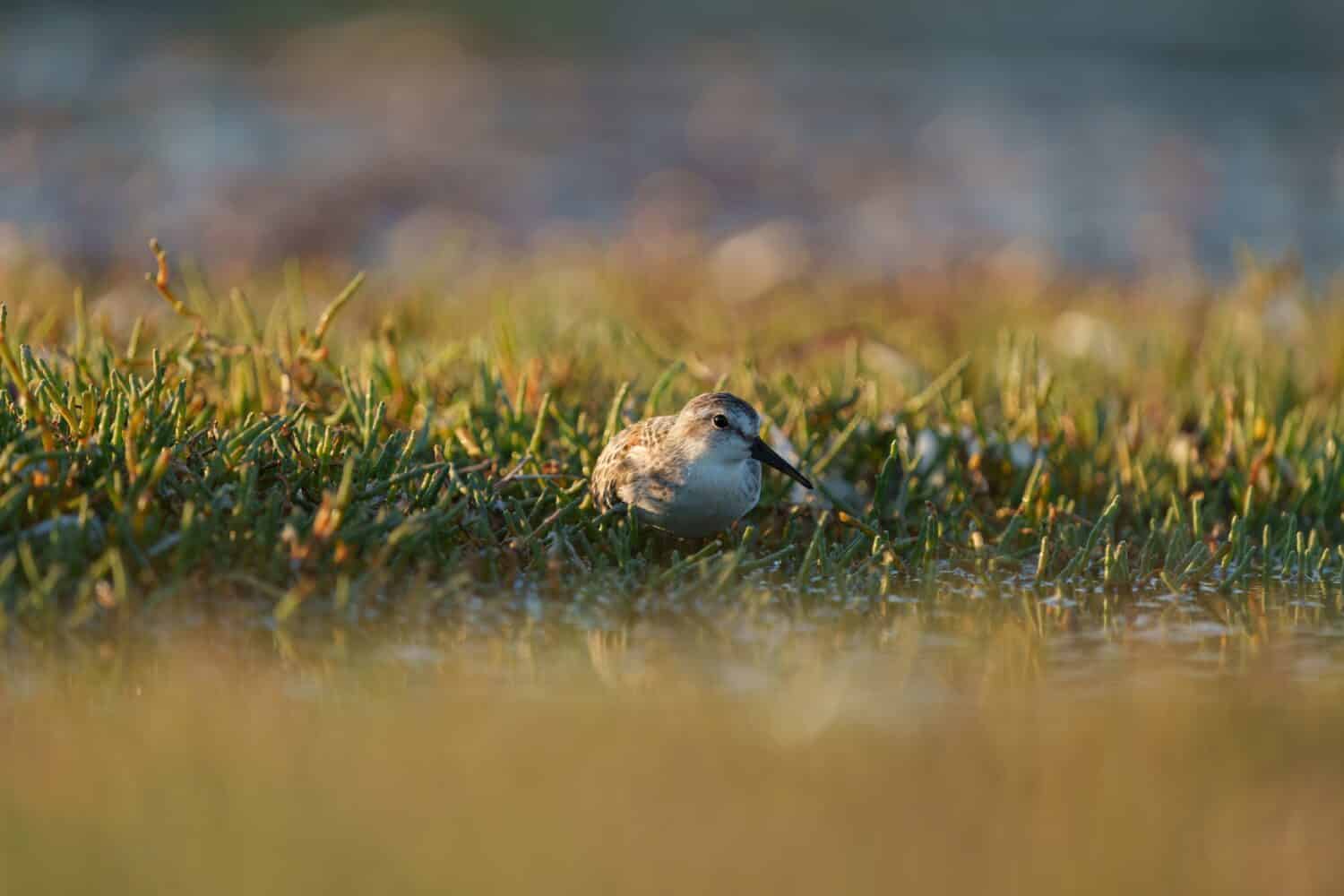
The long-billed dowitcher’s bill is twice the length of its head.
©2009fotofriends/Shutterstock.com
This feathered friend belongs to the sandpiper family and hunts for its food by stitching a sewing pattern underwater to sort out the small mollusks and invertebrates. They also have an exciting mating display as they chase the females while in flight. The length of the long-billed dowitcher is 11.5 inches, and their wingspan is 18.5-19.3 inches. You can spot these birds as they migrate from Canada to Florida for winter.
16. Northern Gannet (Morus bassanus)

Northern gannets are the largest seabirds of the Northern Atlantic.
©Will Hall/Shutterstock.com
Gannets are unusual and striking-looking birds. Not only are they striking looking, but they are fantastic divers when looking for their next meal. They can dive up to 200 feet and appear to do so without rhyme or reason. These big coastal birds are 34 -39 inches long and have a wingspan of 67-71 inches. These extensive feathered works of art are native to Canada and parts of Europe and are similar to boobies. Gannets make their nests from plants, sea debris, and seaweed. They tend to be aggressive towards each other when nesting.
17. Piping Plover (Charadrius melodus)
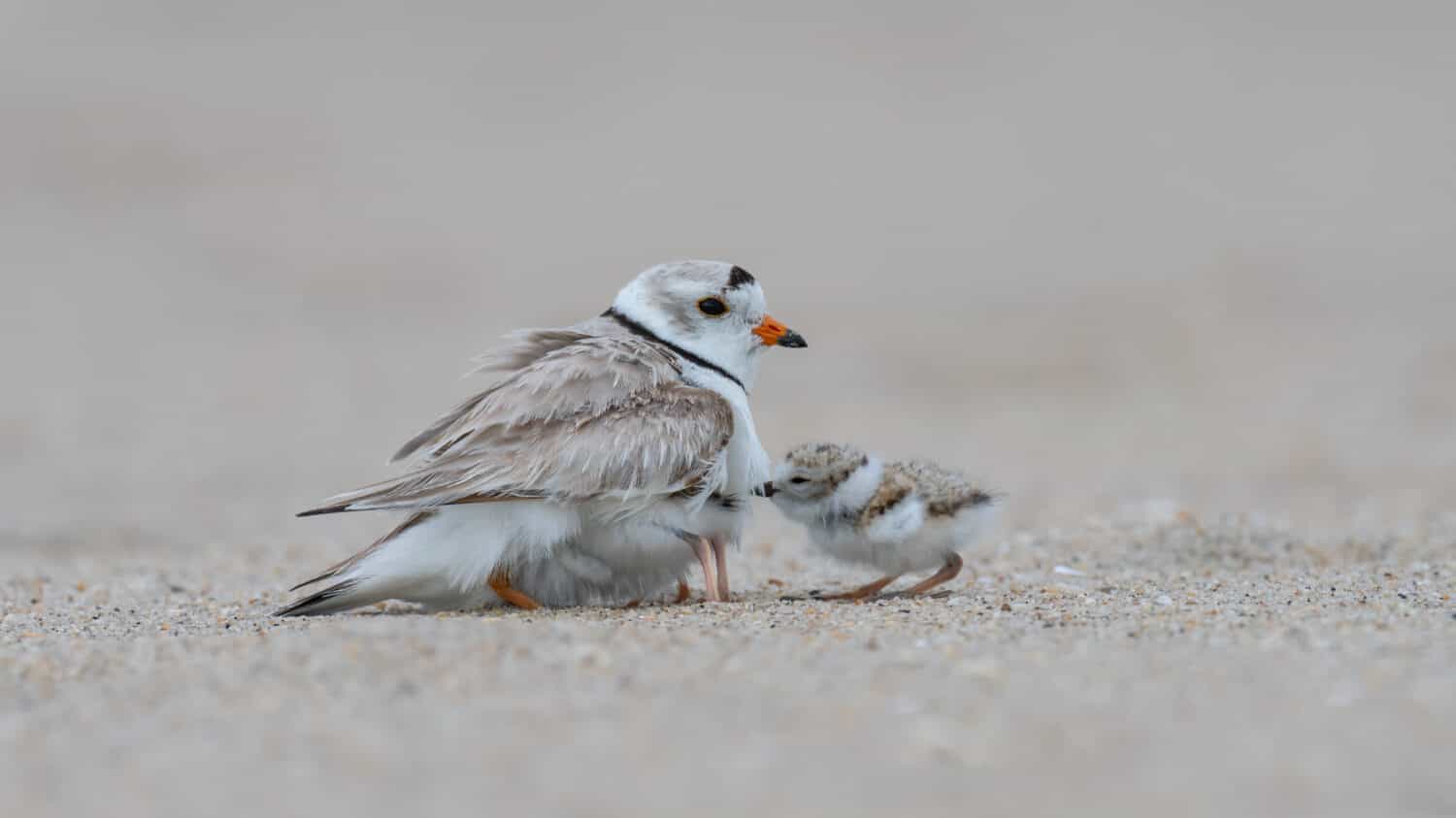
Piping plover males go overboard with their courtship shows and even throw rocks up in the air for attention.
©Randy G. Lubischer/Shutterstock.com
The piping plover is a very small, sparrow-sized coastal bird that can be found on sandy Virginia beaches near the surf. You see these little birds whenever you visit the beach. They are known for their short burst of speed as they hunt for crustaceans as the tide recedes. As the tide comes in, they run on their tiny stilt-like legs as fast as they can to avoid it. Plovers tend to nest very close to the ocean in the dunes. They are only 5.9-7.5 inches long and have a wingspan of 14-16 inches. During the winter months, these little birds migrate to the Bahamas.
18. Prothonotary Warbler (Protonotaria citrea)
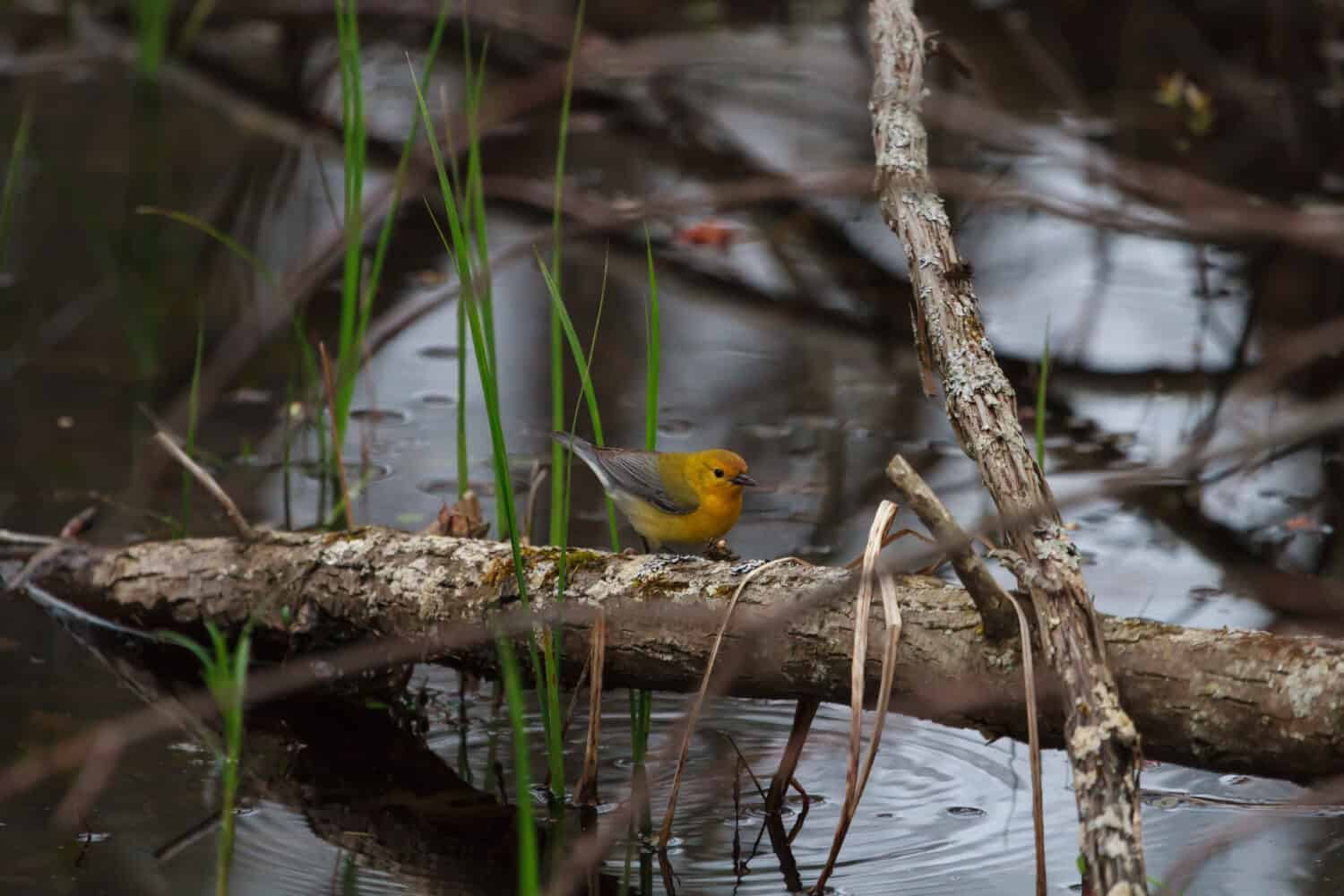
Prothonotary Warblers are beautiful and named for their likeliness to the yellow robes worn by papal clerks in the Roman Catholic church.
©Paul Roedding/Shutterstock.com
This small warbler is known for nesting in artificial or natural cavities. Sometimes they can be found in old woodpecker holes. They are approximately 5 inches long with a wingspan of 8.75 inches. They are big fans of hardwood swamps and tend to stick to those in the eastern United States for breeding grounds. However, their migratory map is not well known, but they spend months in Belize yearly during spring migration.
19. Red Breasted Merganser (Mergus merganser)
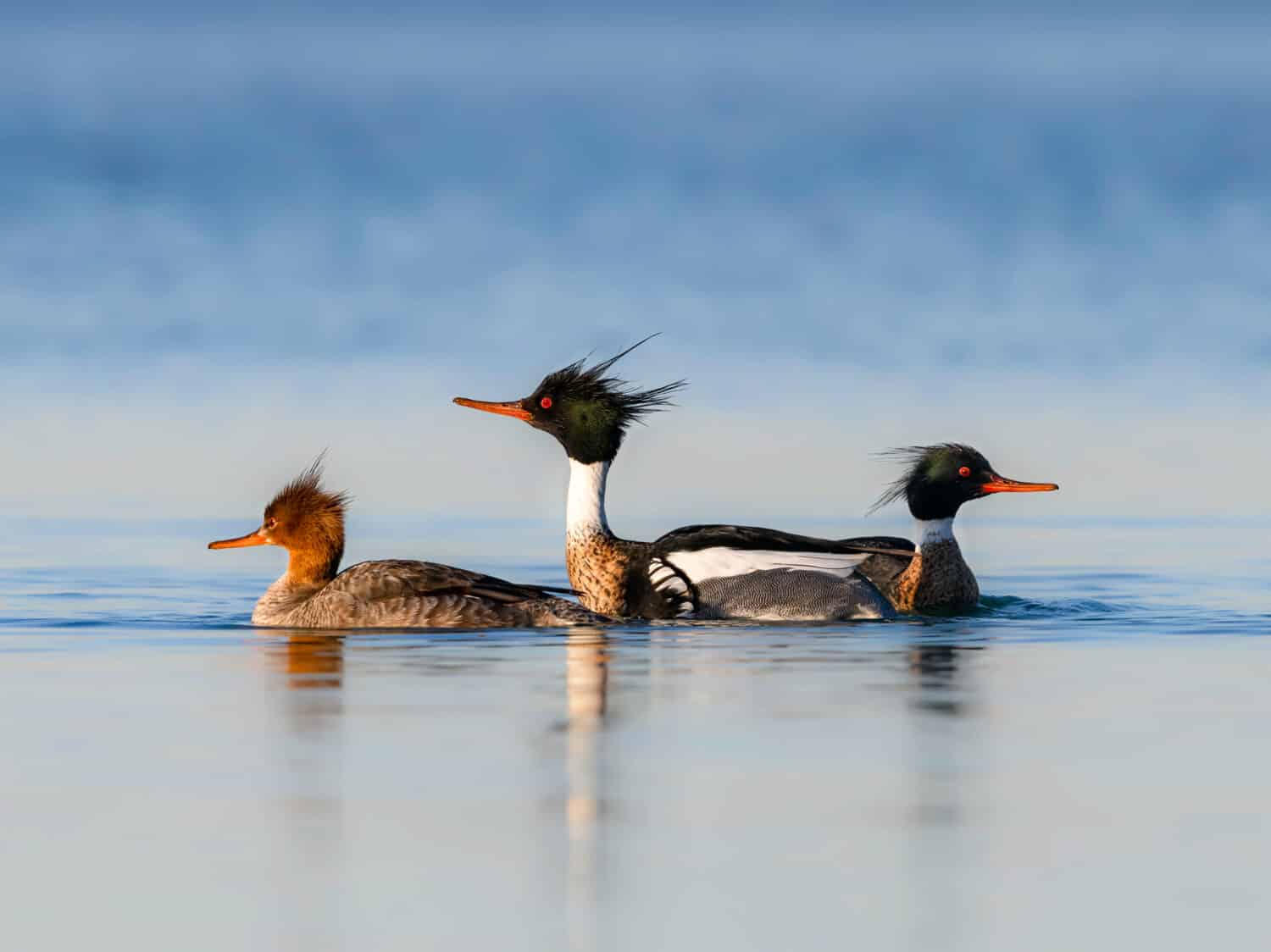
The fastest duck ever recorded was a Red Breasted Merganser at 100mph!
©FotoRequest/Shutterstock.com
These fancy-looking birds come equipped with serrated bills for catching fish. However, their namesake’s red breast only describes the species’ males. The mergansers frequent the coastal waterways in the winter. They are approximately 20-25 inches long with a wingspan of 26-29 inches. During courtship, the males “meow” at the females. They do not breed while in Virginia, so you might have to travel north to see or hear that.
20. Red Knot (Calidris canutus)

The red knot uses its long stilt-like legs to walk through the water.
©Buvana Bala/Shutterstock.com
Each year the red knot travels 9000 miles on its migratory trip from the Artic to the southern tip of South America. The red knot is one of the farthest-traveling migratory birds. These Virginia birds on holiday are the second largest sandpiper at 9.1-10.2 inches in length, and they have a wingspan of 19-21 inches. Both parents incubate the eggs, but once they have hatched, the female leaves the parenting to the male. Their primary source of food is anthropods, spiders, and small crabs. One of their favorite treats is horseshoe crab eggs.
21. Royal Tern (Thalasseus maximus)
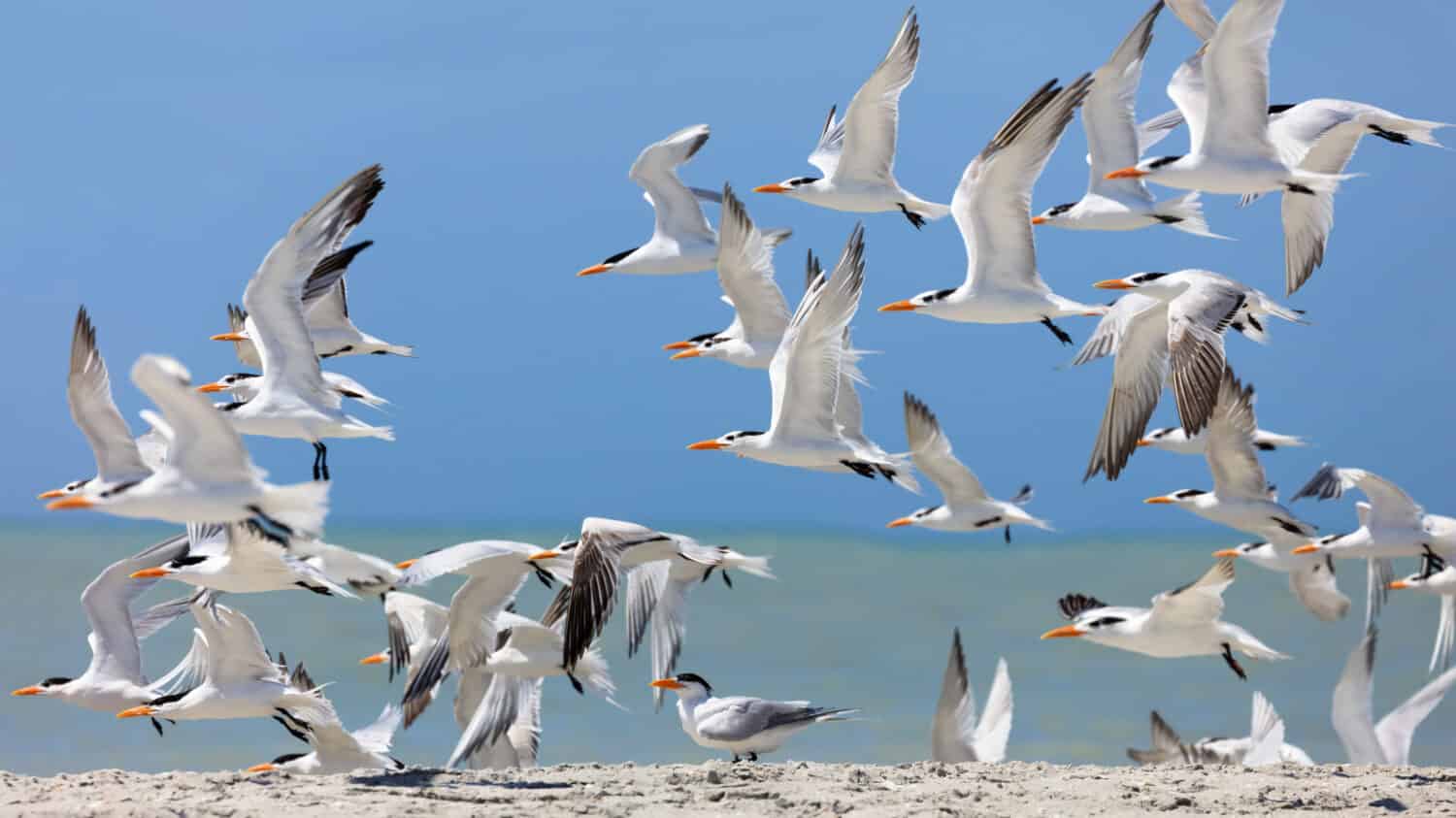
Royal terns mature at four years old, and it is at this time they begin to search for a mate.
©ulrich missbach/Shutterstock.com
The royal tern is a native to the Americas and can be seen in Virginia year-round, specifically during mating season, April through July. They are a large bird and the second largest tern at 18-20 inches with a wingspan of 49-53 inches. These Virginia birds generally stay close to shore or stick to small secluded bodies of water when hunting for food. They lay one or two eggs in a small hole they make on predator-free beaches without much human traffic.
22. Ruddy Turnstone (Arenaria interpres)
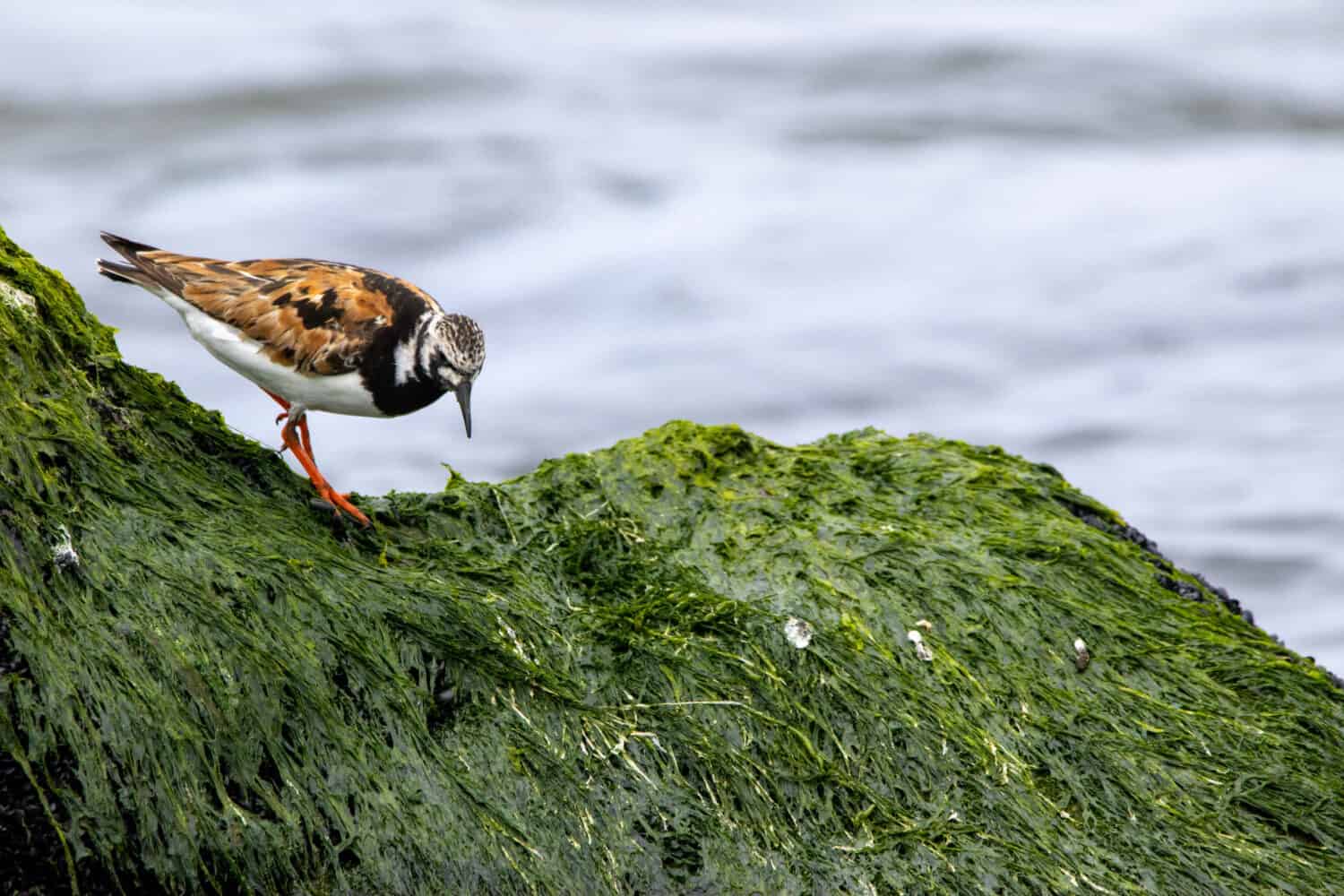
A ruddy turnstone looks for meals by flipping rocks over whenever it can, which is the meaning behind “turnstone.”
©CEW/Shutterstock.com
The ruddy turnstone is a small cosmopolitan wading bird that is small and stocky. They are generally 8.7-9.4 inches long with a wingspan of 20-22 inches. Non-breeding adults are a slightly duller color than breeding adults though they both always have some degree of black and white on their plumage. These birds are rarely found further than a few miles from the ocean, especially during the mating season. They enjoy a diet of eggs, carrion, and fish. They have frequently been spotted dining on the eggs of other bird species at the beach.
23. Semipalmated Plover (Charadrius semipalmatus)
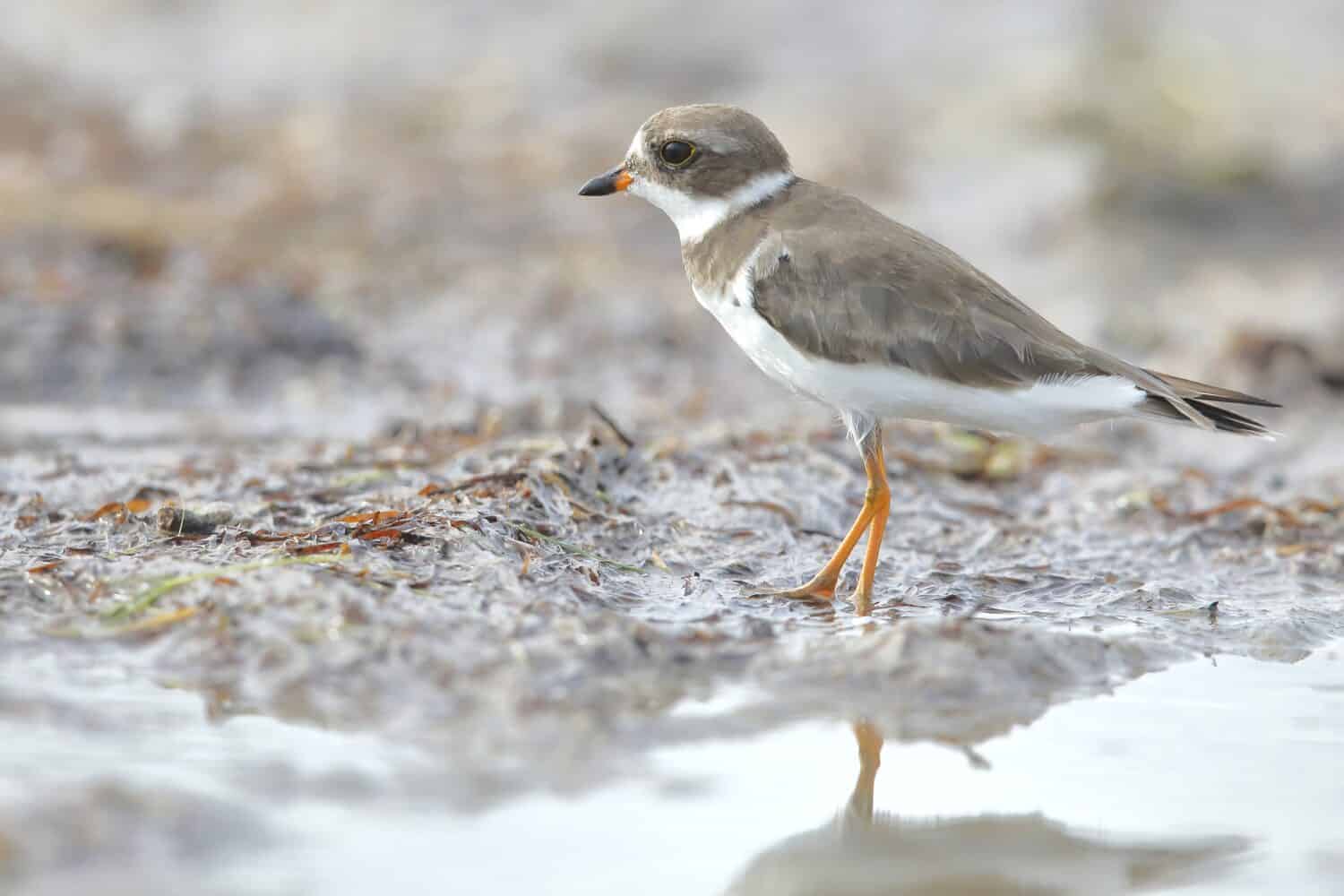
Semipalmated Plover walking amongst the cold mud and muck.
©Kamil Srubar/Shutterstock.com
These plovers enjoy life on the beaches and flat areas of Alaska and Canada and fly south in migration yearly. You can see them on the Virginia coast during the spring and summer mating seasons. They are small birds with a length of 5.5-7.9 inches and have a wingspan of 14-22 inches. Plovers have a unique trick that helps lure predators away from their nests. They act like they are injured or have a broken wing and hobble along until the predator follows them away from their nest.
24. Snow Geese (Anser caerulescens)
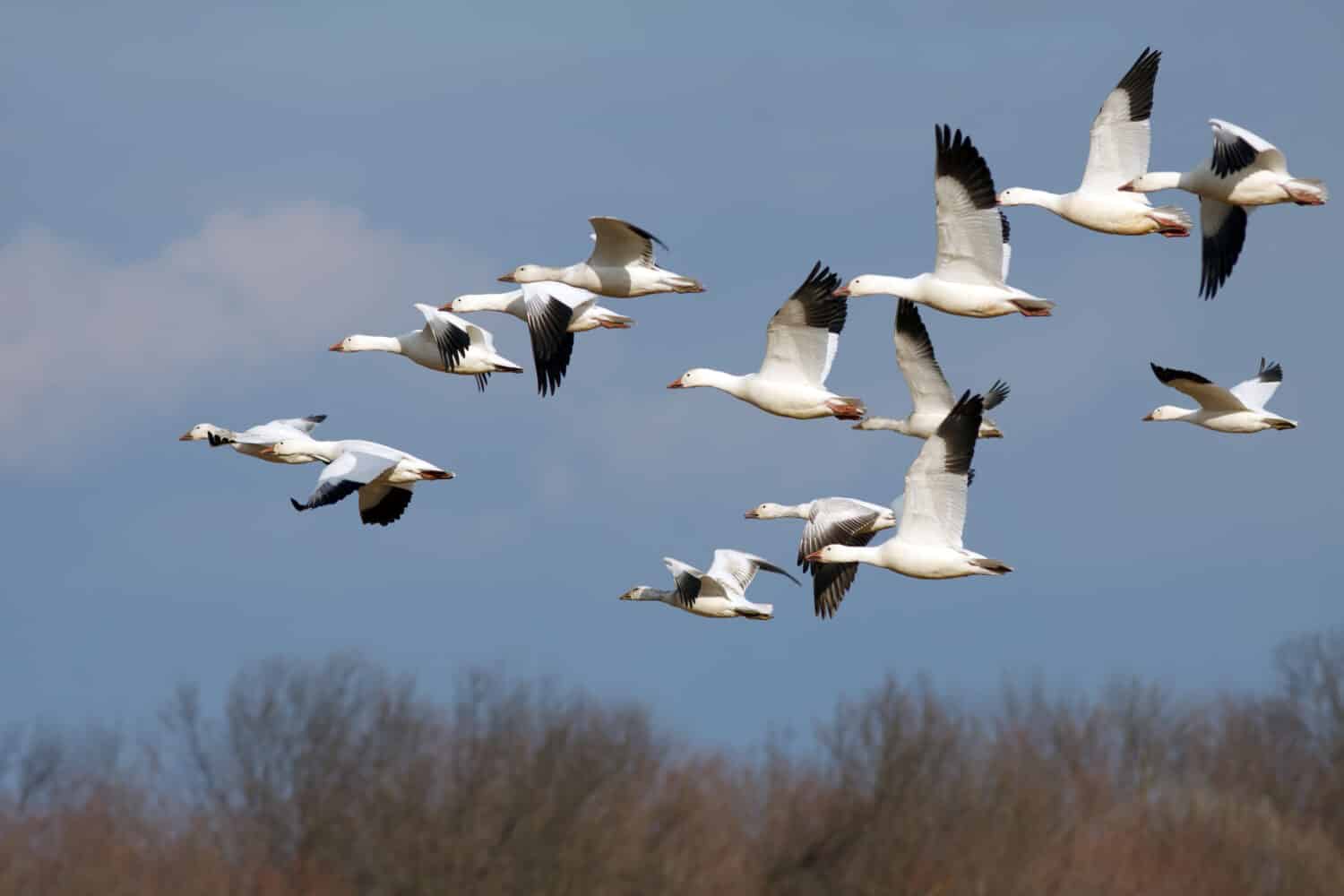
Bald eagles frequently target snow geese during the winter months.
©Delmas Lehman/Shutterstock.com
The snow goose is native to North America. You can see them with white, dark, or sometimes even blue plumage, though white is the most common. When the birds are still immature, they have a bluish tint and become white as they mature. These attractive geese form couple bonds in their second year but only generally mate in their third year. They remain long-term partners, breeding yearly. Often the young stay with their parents where they were born until they reach maturity. These are geese that remain in a flock for feeding and migratory needs.
25. Trumpeter Swan (Cygnus buccinator)

A beautiful trumpeter swan glides gracefully on a quiet Virginia waterway.
©Sharon Morris/Shutterstock.com
The trumpeter swan is the heaviest native bird in North America. It is also one of the largest, with a length of 4 feet 6 inches through five feet five inches and a wingspan of 6 feet 2 inches through 8 feet 2 inches. Their call sounds much like a trumpet which is their namesake. In 1933 these swans were critically endangered, and less than 70 were said to exist. Their numbers are at the least cornered level on the endangered species list. In 2010 there were over 46,000 swans in North America. They prefer to nest and breed in quiet ponds, secluded marshlands, and other undisturbed coastal waterways. Their diet consists of aquatic plants and insects.
26. Tundra Swan (Cygnus columbianus)
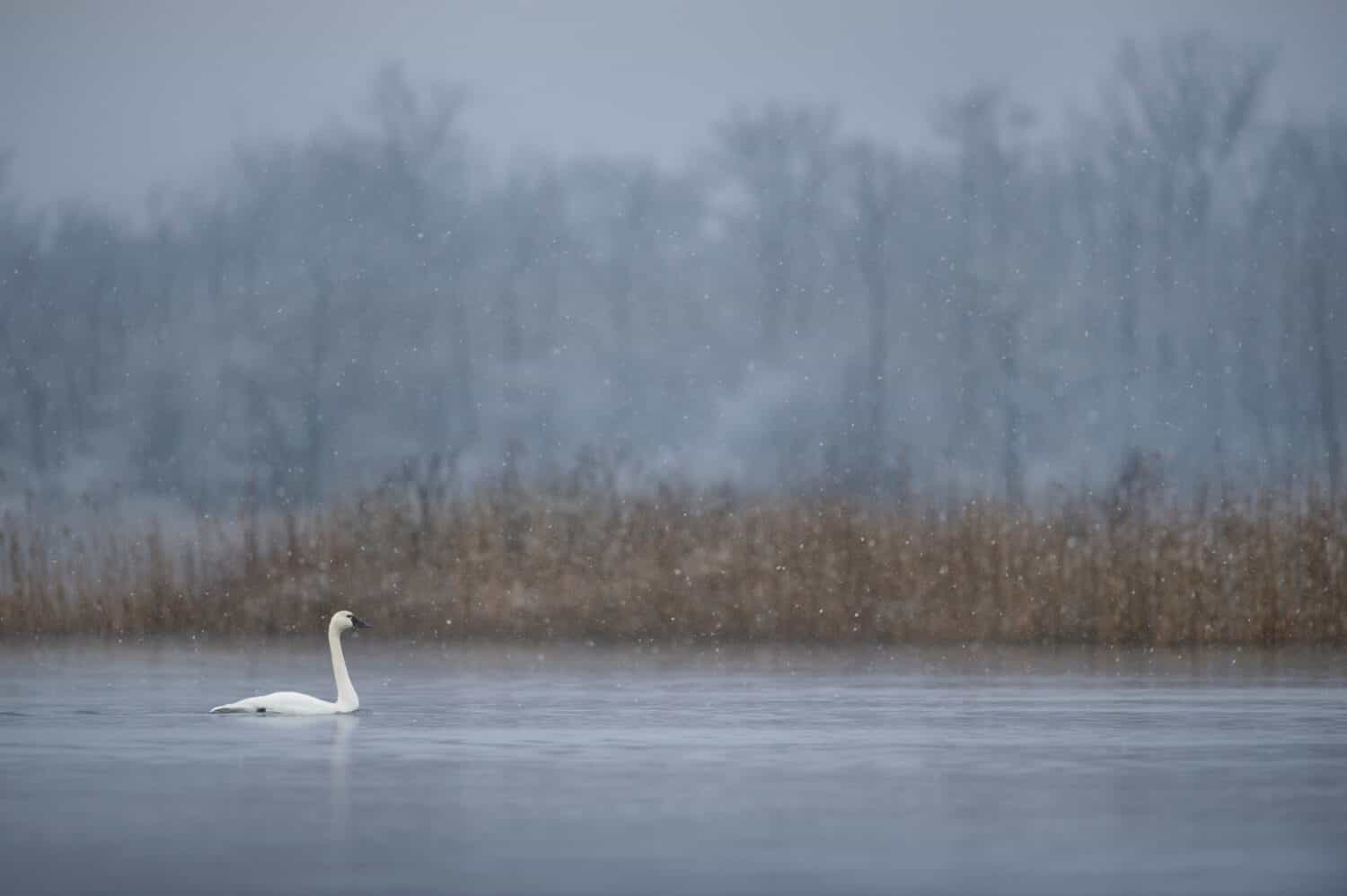
A tundra swan juvenile swims alone on a winter day in Virginia.
©Ray Hennessy/Shutterstock.com
Tundra swans are commonly seen in Virginia coastal waters. These birds are monogamous until their partner dies; even then, they may never breed again. Generally, they make big nests in the marshes, and both parents guard the 3-7 eggs. They can be highly aggressive when protecting their young. However, these swans do not reach maturity until three or four years of age and remain with their families until then. They are large birds with a length of 45-59 inches and a wingspan of 66-83 inches. They are a smaller swan species.
27. Virginia Rail (Rallus limicola)

Virginia Rails are fast and tend to run to escape predators rather than fly.
©Jim Beers/Shutterstock.com
These tiny birds are commonly seen despite the decline in their natural habitat. However, they are very secretive and tend to be heard more than seen in the wild. Adults measure 7.5 -10 inches in length and have a wingspan of 12-15 inches. These small birds have the highest ratio of leg-to-flight muscles of all birds. Also, they are equipped with very long toes to help support them as they walk on floating vegetation. The rails are seen in freshwater and brackish marshes along the coast and sometimes in saltwater marshes in the winter months.
28. Willet (Tringa semipalmata)
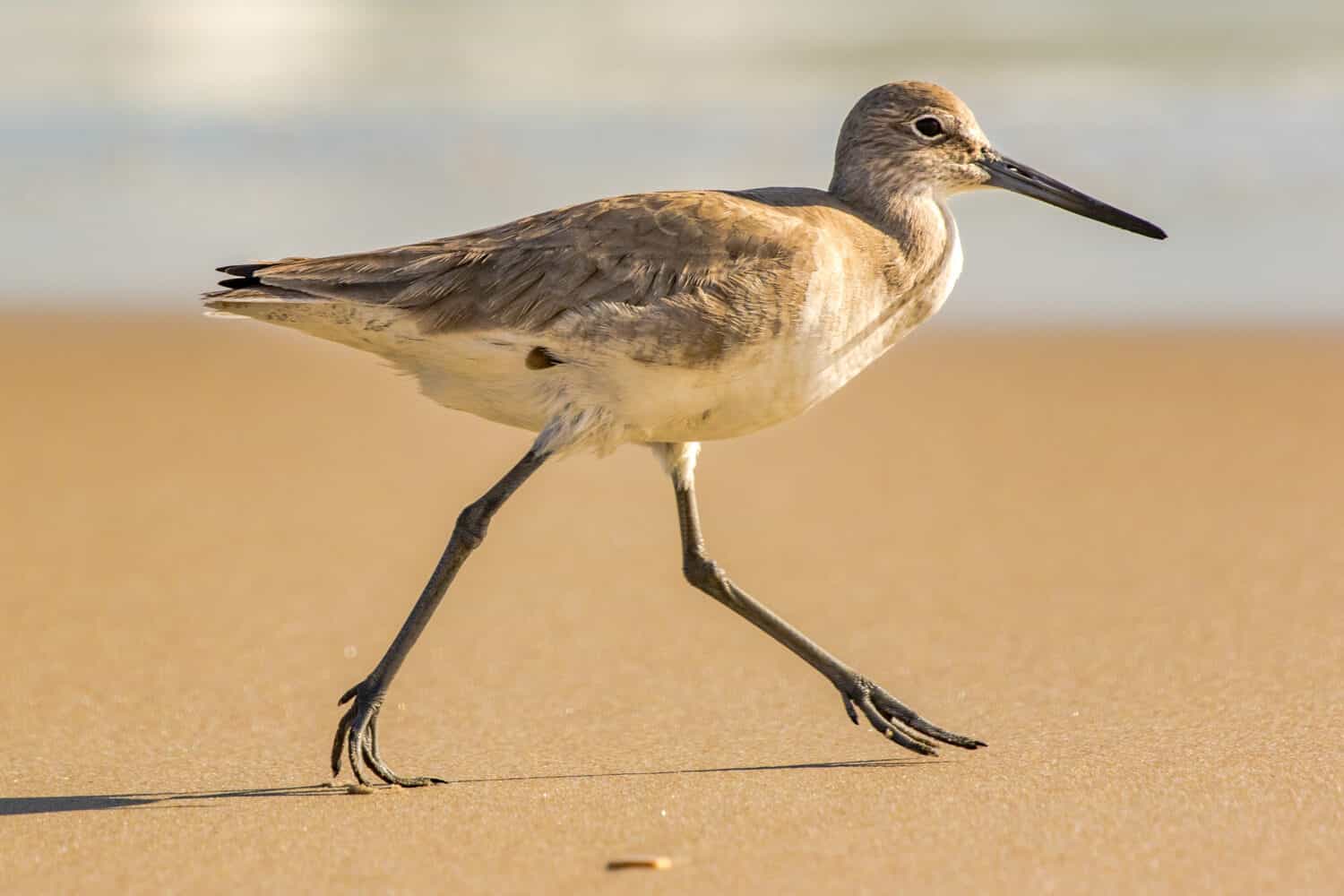
The quick willet races along the winter shoreline catching small crustaceans.
©Mark C. Morris/Shutterstock.com
The quick willet races along the winter shoreline catching small crustaceans.
This large shorebird, a big sandpiper, tends to winter in the southern United States and can often be found in the coastal Virginia waterways. These Virginia birds are 12-16 inches long and have a wingspan of 27 inches. The willet gets its name from its territorial call, “pill-will-willet.” They tend to make their nests in freshwater marsh grasses and wetlands. They can be seen on sandy or rocky beaches in the winter. Among their favorite foods are mole crabs, fiddler crabs, small invertebrates, and worms.
29. Wilson’s Snipe (Gallinago delicata)

The small, speckled Wilson’s snipe forages for worms and vegetation along the riverbank.
©FotoRequest/Shutterstock.com
The small, speckled Wilson’s snipe forages for worms and vegetation along the riverbank.
This small, stocky shorebird is cute and has a very long bill, which enables it to be an excellent forager. Adults are only 9-11 inches long and have a wingspan of 15-18 inches. Their breeding grounds consist of bogs, marshes, and wetlands in the northern United States and Canada. They tend to migrate south in the winter when you will most likely see them on the sandy beaches of Virginia. Wilson’s snipes are very timid birds and tend to avoid humans whenever possible. They have a fantastic in-flight trick of zig-zagging to distract and confuse predators.
30. Yellow-Rumped Warbler (Dendroica coronata)

A yellow-rumped warbler can frequently dine on fruits from poison ivy and oak.
©Gerald A. DeBoer/Shutterstock.com
A yellow-rumped warbler can frequently dine on fruits from poison ivy and oak.
This bird is widespread in North America, on the Atlantic and Pacific coasts year-round. These pretty little Virginia birds prefer insects but also enjoy eating juniper berries, especially in the winter. The average length of the yellow-rumped warbler is 4.7-5.9 inches, and they have a wingspan of 7.5-9.4 inches. They are seen flitting like flycatchers in swooping motions to scoop up the maximum amount of insects from their perches. These small birds generally migrate at night.
The photo featured at the top of this post is © BlueBarronPhoto/Shutterstock.com
Thank you for reading! Have some feedback for us? Contact the AZ Animals editorial team.







